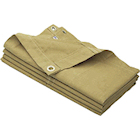Canvas & Tarps
When you think of a geodesic dome cover many of us think of tarps first, those blue and green ones we find at the hardware store. After all they are inexpensive and have a good tensile strength, even in economy versions.
Polyethylene tarps or PVC laminated tarpaulins are rip-stop because they are weaved and so a tear will not run unless you apply great stress, lightweight plastic tarps with excellent wear, low-moisture and stain-resistant properties. This makes them superior to traditional canvas tarps for many applications. Though blue is the most common color, they also come in silver or gray, white, green, clear and black.
See below the different types of tarps and choose the one best suited to your budget and needs to cover your geodesic dome.
Poly laminated tarps |
Also reffered to as the econo tarp (those blue and green tarps sold everywhere), they can be used in many different applications. Polyethylene covers are the most common type of cover available today. Uses for these tarps are endless. Also available in various colors and sizes, they are heavy-duty, often treated to be UV resistant, waterproof, lightweight and inexpensive. A typical one will have grommets every 36 inches and a rope inside its edges for additional strength. For a more detailed explanation of woven poly, please view the woven poly page on this site.Below is a typical set of specifications for poly laminated tarps (source: CanopiesAndTarps.com) .
|
||||||||||
Poly mesh tarps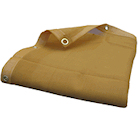 |
Used in tennis courts, construction sites, pool covers, gardening and much more. A durable and UV treated fabric, the high density of the mesh fabric blocks 75% of sunlight while still allowing air and cool breezes. Grommets/eyelets are typically spaced at every 18 inches with rope-reinforced corners and eyelets.Mesh Tarps adapt to any weather condition. Typically they are rated at 75% shade with a 25% light admittance with grommets every 12 inches but are available up to 90% shading. Below is a typical set of specifications for poly mesh tarps (source: CanopiesAndTarps.com) .
|
||||||||||
Vinyl laminated Tarps |
Vinyl Tarps are ideal covers for many different applications and are commonly used as divider curtains, gym floor covers, salvage covers, welding curtains and are even great for paint booths. The thick laminated surface is both Fire Retardant and durable for indoor/outdoor use. Vinyl Tarps make great truck tarps for industrial applications and are also ideal as heavy-duty hay covers for the farming industry. Below is a typical set of specifications for vinyl laminated tarps (source: CanopiesAndTarps.com) .
|
||||||||||
Vinyl mesh tarps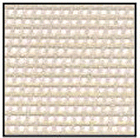 |
Vinyl Mesh Screen Tarps have multiple applications outdoors in construction and sun shading among others. As the name implies, this is a mesh and therefore not weatherproof. On the plus side it’s a simple way to create a shaded area where a breeze is let in for added comfort. Below is a typical set of specifications for vinyl mesh tarps (source: CanopiesAndTarps.com) .
|
||||||||||
| Canvas tarps
|
Canvas Tarps are ideal to protect valuable equipment or to simply conceal it. Commonly made from a high-quality military grade cotton. Available in 4 colors, each cover is hand made at the time of purchase for the best quality available on the market today. Hem lines and seams are generally hand-stitched, this fabric will last generations when well maintained. Below is a typical set of specifications for canvas tarps (source: CanopiesAndTarps.com) .
|
||||||||||
Fire retardant tarps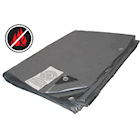 |
Most city and state municipalities have regulations regarding outdoor frame structures, such as the use of fire retardant materials. Across North America you can be sure your area has specific rules as to using tarps. Below is a typical set of specifications for fire retardant tarps (source: CanopiesAndTarps.com) .
|
||||||||||
Terms to understand when purchasing tarps
Denier: a unit of measure to identify the density of fibers, similar to how bed sheeting is identified. A Denier is the mass in grams per 9000 meters (so 1 denier = 1 gram per 9000 meters). The higher the denier count, the greater tensile strength.
Mil: a unit of length equal to one thousandth of an inch (0.0254 millimeter) used to identify the diameter of wire or the thickness of materials sold in sheets and rolls.
Geodesic dome covers: 2 types stand out
Large white tarps: White tarps are often used for their increased reflection of sunlight and used in outdoor settings. You will see them used as truck covers, as a portable garage tarp or an RV cover. Large white tarps can be as large as 50 by 100 square feet and have properties inclding being waterproof, resistant to UV rays, tears and abrasions, mildew and rot. You can also find white tarps with fire retardant properties.
Silver poly tarps: These are commonly designed with an extra-heavy U.V. protection, stronger eyelets/grommets and overall better quality. You can find silver tarps used as waterproof barriers, roofing, landscaping, boat covers and any other applications requiring protection from outdoor exposure to sun, wind, and weathering.
Many silver tarps have eyelets/grommets every 18 inches instead of the typical 36 inch distance. The UV treatment is typically 40 micron and resistant to mildew, tears, even acid. As an added feature silver poly tarps remain flexible in Arctic conditions. also note that the treatment for these tarps is usually on both sides of the tarp. Premium silver poly tarps normally weigh around 6.0 oz. per square yard with a tensile strength of 1200 Denier.
You should always check for thickness, treatment and tensile strength: there are some “premium” silver poly tarps with 1600 denier and 12 mil thickness. A typically blue tarp is 4.5 oz. per square yard with a tensile strength of just 900 Denier.
Making The Right Choice In Poly Tarps
Color: There are several colors available, but the most common are blue and green. They are lighter and less durable than other types, but are also the least expensive. Camouflage tarps are often used by hunters and campers, but there are fewer size options. Silver is used for its’ reflective characteristic, and is roughly twice as thick and durable.
Exposure Tolerance: Reinforced polyethylene is water repellant, mildew and rot resistant, and it can be formulated to resist the build-up and retention of electrostatic charges that may be harmful to certain sensitive equipment. Most quality polyethylene is treated to provide UV protection, even more so with silver poly tarps.
Construction: Standard design will include sewn or heat-sealed seams, sometimes a rope sewn into the hem, grommets every 2-3 feet along the edge, and reinforced corners.
Tarp straps allow easy placement of your tarp.
Fabric Strength: Typical lightweight materials are 700-800 denier(thread size) material in a 8×8 thread mesh, with 5-6 mil(thickness) and up polyethylene laminate on each side. Heavy-duty silver tarps generally have a 14×14 mesh, 1000 denier thread, and a 11-12 mil thick laminate. Obviously, the greater any of these measurements, the stronger the tarp.
Fabricating and manipulating tarps
| Gluing Tarps | All sorts of plastic and canvas tarps can be glued. Follow the manufacturer’s instructions for the particular patch kit being used. These patch kits typically contain a fabric patch to match the tarp and adhesive, but kits containing tape are also used. It is advisable to apply a waterproof coating to the patch after it dries. | |
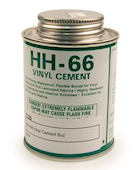 |
Example of a tarp adhesive: HH-66 is a fast drying (2-5 minutes), waterproof, solvent-synthetic resin adhesive. It is used extensively for bonding vinyl coated and vinyl laminated fabrics.HH-66 dries hard and very strong, yet remains flexible. It is not affected by weather and temperature extremes, and is highly resistant to oil, fuel, grease, and many chemicals. Quart covers approximately 8 Square Feet. | |
| Sewing Tarps | You sew a heavy-duty tarp using a heavy-duty machine or by hand with a special needle called a sailmaker’s needle. Sewn repairs should be made waterproof. You can use beeswax or use a specialized reinforcement tape. Normal ply polypro tarp material can easily be sewn by a normal household machine with a big zig zag stitch; no need to go to an industrial grade sewing machine. | |
| Double or triple ply material can cause problems when using a household sewing machine. When the stiching comes under strain woven strands often pull away from the stitches. To remedy this you can use tarp-specific glue and in addition, sew the pieces together. For even more strength use a strip of fabric to cover your seam and stitch it in place. | ||
| If you don’t want to redo stitches a second time, you can use reinforcement tape before sewing the seam.Cotton, nylon strips or tape reinforce the seams and add significant strength to the grommets. | ||
| On most tarps the original eyelets/grommets were never designed for a geodesic dome cover that will be sewn into a very large piece. That does not mean all eyelets will rip out; some tarps have reinforced eyelets and already have a solid hold to the tarp. | ||
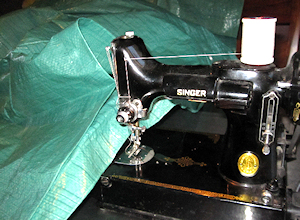
When sewing tarp, it is recommended to use reinforcement tape or a nylon strip. |
||
| Replacing Grommets | Replacing grommets requires neither gluing nor sewing. It is preferable to use a new hole and take the opportunity to reinforce the area as mentioned above. | |
| Welding tarp sections together | Plastic tarpaulins and coated textiles can be reliably welded using hot air. Overlap them by approximately 3/4″ or 2-4 cm. Hot air at approximately 300-400 °C) is then blown between the overlap. Within seconds the material turns soft at which point you keep both layers pressed together by using a feed roller. To test if your temperature was correct, first try this on a sample. If stress whitening occurs in the material then the seam is well done. If you do not see the whitening the temperature or the roller pressure applied needs to be increased. | |


